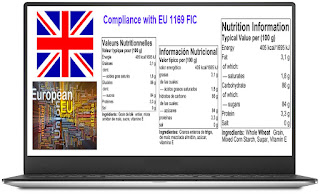European Union Nutrition Facts Labels
Labeling laws in the European Union enable consumers to access full information about food nutrients. Food quality information labels assist customers in making educated food purchases. Food information and labeling are governed by EU regulation No. 1169/2011, which establishes general standards, criteria, and obligations. The aim of enacting this rule is to protect consumers' rights to food nutrient knowledge. This law applies to food business owners, food manufacturers, food service providers, and anyone who needs food analysis and labeling.
The emergence of advanced online applications has made it easier for foodservice providers and food manufacturers to create European Union nutrition facts labels in compliance with the guidelines.
Now, take a look at the important information of European Union(EU) food labeling:
1. The food's name
2. Ingredients' list
3. Any ingredient or processing aid used in the manufacturing or preparation of food that is derived from a material or product that causes allergies or intolerances.
4. Quantity of such products or ingredient groups
5. The food's net quantity
6. The ‘use by date or the ‘best before date is the date of minimum longevity.
7. Special storage and/or consumption requirements are listed.
8. Name or company name, as well as address
9. Originating nation
10. Useful knowledge
11.Nutritional Statement
Nutritionist Pro is a robust nutrition food label maker application that allows users to create European Union nutrition facts labels quickly and easily at a low cost. It allows users to create unlimited food label styles and food labels in English, French, and Spanish. It also helps users to build unlimited recipes/formulas from a large European food database.


Comments
Post a Comment